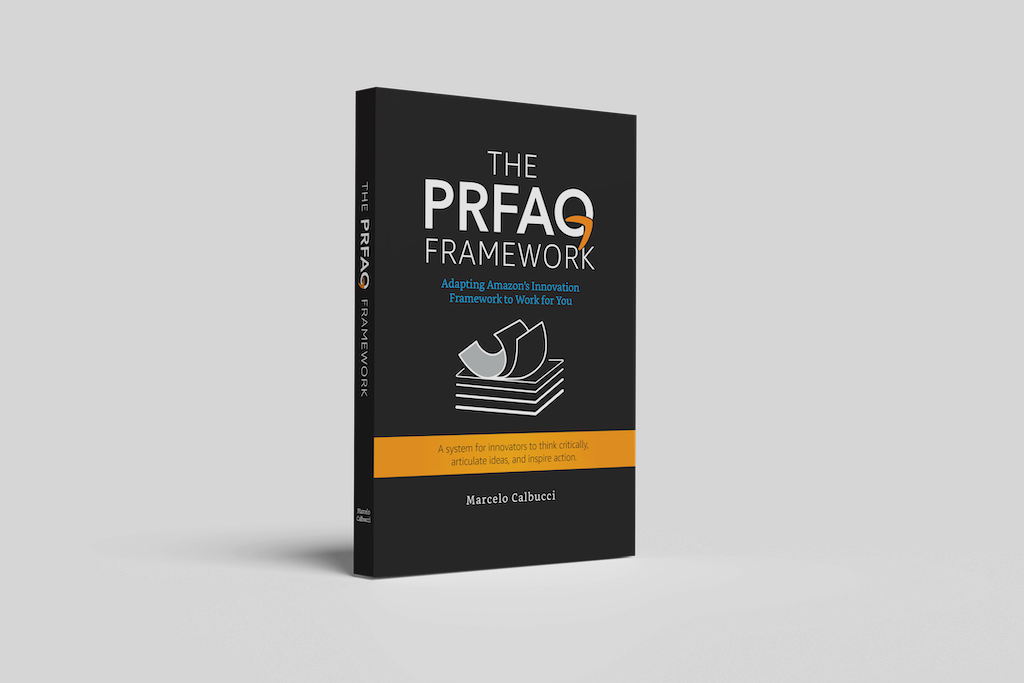Why you must write PRFAQs before OKRs
A guest blog post from Marcelo Calbucci, author of The PRFAQ Framework

Objectives and Key Results (OKRs) provide a framework for teams to agree on ambitious objectives and measurable results. The book Measure What Matters by John Doerr was the tipping point in the mass adoption of this framework. The book promises OKRs align teams, foster innovation, and drive performance. Here’s what the book description says:
OKRs surface an organization’s most important work. They focus effort and foster coordination. They keep employees on track. They link objectives across silos to unify and strengthen the entire company. Along the way, OKRs enhance workplace satisfaction and boost retention.
It’s frustrating if you embraced, implemented, and refined the OKR process in your organization and it still not working as expected. Why are teams not aligning and moving fast? Why are teams meeting or exceeding their OKRs, but you still feel uneasy about how well the business is doing? Why do teams keep changing OKRs from quarter to quarter and creating this elaborate planning process that consumes so much of their time? And, they still are working in silos and not coordinated!
Oh, I’ve been there. It took a herculean effort to plan this way—to come up with the right OKRs for each team and each layer of the organization. We’ve made it work, but it was costly. There was something missing. OKRs could not account for that.
Strategy is missing!
OKRs rarely include mentions of the customer and the impact on them. They don’t have a coherent story and feel like a collection of metrics the team is aiming for. There isn’t a narrative that ties them together.
There are many mistakes that people make when using OKRs. The big ones that matter to this article are: 1) creating vague objectives that lack clear outcomes, 2) focusing on activities and outputs, instead of outcomes, and 3) misaligned OKRs across teams and with the broader organization. You know what these three issues have in common? They are consequences of a lack of clear vision and strategy.
Without a shared vision and strategy, OKRs will trickle down and teams will pick the pieces they own without understanding the why. In that scenario, teams need to collaborate more to ensure other teams have OKRs that will support them in the quarter. This complex dependency graph takes immense effort and time to resolve.
This “standard” approach to OKR drives teams to have an excessive overhead for planning or cutting short of a proper one. The first will lead to teams that will deliver at a slower speed than they are capable of. The latter leads to misalignment across the organization and frustrated team members. It even leads to backstabbing since team members don’t want to be known as the person who missed their OKR. Does that sound like it enhances workplace satisfaction to you?
Where does the PRFAQ fit in?
If you are reading this article, you have a sense of what a PRFAQ is. The PRFAQ framework provides a way for teams to discover, debate, and decide on strategy and vision. It’s a system to think critically, articulate ideas, and inspire action. Any project or initiative, big or small, in an organization must start with a PRFAQ—from starting a whole new business to adding features to an existing product, from changing a recruiting or customer service program to replacing the accounting vendor, from updating an old backend service to shutting down an office site. The team must use a PRFAQ until it reaches a decision about a strategy and vision.
This takes weeks, and it’s time well spent because it reduces team misalignment and working in silos since they will share an understanding of the purpose of the project. It also helps teams set OKRs that are actually aligned with what the organization (or project) is aiming for. There are other advantages to PRFAQ, unrelated to improvements to the OKR process, such as the customer-centric mindset, working backward from aspirational and ambitious impact, and much more.
Let’s see how PRFAQs help with the OKR framework issues listed above.
OKR Issue #1: Vague objectives without clear outcomes
If you don’t have a clear vision and strategy working backward from the customer, how do you expect teams to write clear OKRs? It’s shocking the number of organizations that don’t have a strategy in place. People use hand-wave gestures, point to shallow PowerPoints, and state things that were mentioned during the VP town hall three months ago. Is that the strategy? Have people internalized it and are they capable of repeating it to new employees? More commonly, what you find are organizations that have a collection of tactics they call it a strategy. They point to a series of features and call it product strategy. They point to a series of HR programs and call it people strategy. They have a grab bag of marketing tactics and call it a marketing strategy. I assure you, that’s not it.
PRFAQs provide an integrated strategy framework while avoiding the tactical elements of a project or initiative. The consequence is that it focuses everybody’s energy on the important “stuff.” Think like this: you and your partner haven’t agreed on where the next vacation will be. Does it matter to discuss which rental car company to use, which airline to fly, and which pieces of clothes to pack? Once a strategy and a vision are in place, the objectives become clearer. What matters becomes evident in the PRFAQ. You simply lift it and convert it into an OKR.
OKR Issue #2: Focusing on activities and outputs, not outcomes
When the team doesn’t understand the vision and the strategy behind a project, they will rely on what they know well—their craft. Regardless if they are software engineers, recruiters, designers, lawyers, or what have you. Without understanding vision and strategy, employees will ask themselves, “What was I hired to do?” and make up OKRs that fit that mold. What you end up with are OKRs that are about busy work—upgrading the backend service, changing the referral bonus program, redesigning the homepage, or reviewing the contracts and categorizing their risk. Can you imagine a team member saying, “I’m a designer, and I don’t think there is anything for me to do this quarter, so I’ll sit this one out?” It’ll never happen. They will make up work, but align enough with the organization’s OKR so it feels right. Yet, it’s detached from the strategy, because there is none! You end up with activities that might add value, not add value, or worse, decrease value for the product or business! It’s an organization impact lottery.
Once a PRFAQ is in place, team members take over and pick up where the PRFAQ ends: the planning and execution. Objectives will organically become about outcomes, the PRFAQ outcomes, that everyone understands.
Issue #3: Misaligned OKRs across teams and with the broader organization
One problem with cascading OKRs or cross-team OKRs is that the objective gets diluted as it trickles down (or sideways) until no one knows how it impacts the mission—the “why” behind them. I’ve seen teams extend how they do OKR to address this problem, by including an “extended version” of the objective. The main reason is to help others who’ll collaborate on the project to not lose the plot. It’s useful for bubbling information up the chain, as well. Once you go two or three layers up in the management chain, context gets lost, and it’s tough for a VP or CxO to evaluate the merits of an OKR.
Although that solution is not bad, it’s a bandaid to a full-on strategy, such as the one you capture in a PRFAQ. Strategy and vision are easier to discuss when talking across teams and up the management chain. It’s harder for a CMO to read a document that explains the tactical details of different LLM models for content generation than it is for them to understand the problems, solutions, and benefits of adopting LLMs to automate marketing activities. That’s also true across teams. It’s easier for the sales and product teams to provide feedback in a marketing strategy document than for them to provide feedback on an OKR that sounds great but has no meat in it. Yes, I do want to “increase our Marketing Qualified Leads (MQLs) by 20% using content marketing,” but what exactly is the strategy behind it and why are we doing it (vision/mission)?
Fitting PRFAQs with OKRs
A PRFAQ for a small initiative might last a quarter, but more likely, it’ll span multiple quarters or years. If you have to revisit a strategy for a product, program, or business every quarter, you haven’t found the right strategy yet. That’s OK, as long as everyone knows the team is doing experimentation and discovery. Once something works, you stick to it.
Once an initiative from a PRFAQ is in motion—they approved the PRFAQ—you derive the OKRs quarter after quarter from the PRFAQ. You will have a heavier load of PRFAQs to write towards the end of the year, to prepare for the following year, or when there is a top-down decision to shift strategies. That requires many aspects of the business to go through a transformation.
In a typical tech product team, you want the product managers, managers, directors, and VPs writing the PRFAQs in the middle of the quarter. Then, reviewing and revising it in the last month of the quarter, and getting them approved just before teams plan their OKRs and their activities for the quarter.
Takeaways
No matter how good your team is at OKR planning, you are likely still dealing with misalignment, planning overhead, ambiguity, and efficiency issues. Writing PRFAQs before you do quarterly or annual planning will help ease or eliminate many of these issues, and make sure that the team works backwards from the customers and the desired outcomes for the business. One of the biggest benefits of PRFAQ is the collaborative method behind it, helping everyone, from individual contributors to executives, feel listened to and bought into the story.
Leave a review of The PRFAQ Framework on Amazon to help others find the book and follow (and share) Marcelo's newsletter.





